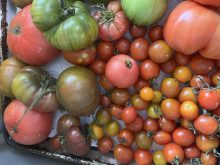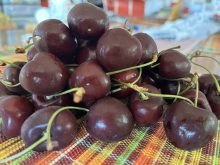Here at my home turf in southern Manitoba, there are community gardens. The property owner rents out a piece of land during the summer to gardeners who are eager to do their own thing, and there’s always a waiting list to get a spot.
The emphasis on planting as much of our own food as possible continues at a high pace. Indeed, the urge to garden has accelerated during the past few years all across the country because of COVID-19 and other health issues, the high cost of food, food shortages and transportation challenges.
My own garden space is about an acre in size. Seems I’ve owned it forever and a day and I’m happy about that. What with personal appearances, garden talks, singing, writing and getting older — the latter applies to all of us — there’s less time to garden, so some hired help has been an asset to me.
Read Also

Gentle treatments for pain in the neck
Heading toward year-end, people unknowingly tense up against the cold and busyness, causing neck pain that can often be treated with appropriate support and gentle mobility, athletic therapist Kathlyn Hossack says.
During personal appearances I often sing some of my originals such as “The Flu Bug Song” and “Gardeners Love to Party.” I wrote those more than 20 years ago.
Sometimes I think of my late friend Kathleen, who lived well into her 90s. She loved to make melt-in-your-mouth cabbage rolls and had her own special knack for steam-cooking them in her oven, so the cabbage was never chewy. Her cabbage rolls and perogies were always in demand from a standing list of steady customers and others waiting to get on the list.
I recall driving Kay (as I called her) to Mayfair Farms on the Island on the Prairies in Portage la Prairie, Man., to purchase bags and bags of cabbages. She had a tough-as-nails homemade cabbage shredder. We’d shred cabbages for hours, layering the shreds in a crock with coarse salt, then tamping it down.
Many readers will know the rest of the story. The end product was homemade sauerkraut in its own juice — about the best natural food and juice for gut and digestive problems to be had anywhere. I often tell individuals and audience clientele to eat long shreds of sauerkraut for long life.
Of interest is a commercial sauerkraut product from Germany called Kühne made with shredded red cabbage, apples, apple juice, black currant juice and vinegar.
I was fortunate to acquire a Traditional Ukrainian Cookery book by Savella Stechishin, so there’s more to say about Ukrainian cabbage rolls, known as holubtsi. You’ll also read about a garden plant known as collards, which is related to cabbage and other members of the brassica family.
Our Canadian flag could be the most readily recognized flag on earth. There’s a bit of a breeze today so my flag is flying high, wide and handsome at the moment. It greets me every morning and reminds me that “I’m proud to sing O Canada,” the name of another song I’ve written. I tip my hat of welcome to our family of Grainews readers and may each of you experience the best of a best day. Know that you are always welcome. Keep reading. There’s more to come.
Top bunch collards
Forget about the gym. Let’s go out to the garden for some essential oxygenated physical therapy and plant something edible that’s early, exciting, nurturing and health promoting.
I suggest Top Bunch collards. Besides the benefit of being physically active, there are also benefits from watching seeds sprout, seeing birds, bees and butterflies and connecting with nature, having nutritious food to eat and sharing our experiences with others doing the same thing.
Yes, there has always been and always will be a bright future for gardening as a lifestyle. It’s the only gardeners’ cocktail we need.
Top Bunch collard leaves can be used for making cabbage rolls and as a wrap for low-carb veggie ingredients or whatever type of filling suits your fancy. Top Bunch collards are the earliest maturing variety known, maturing in 50-70 days. Plants grow upwards, away from soil, and produce leaves that can measure more than 60 centimetres (24 inches) from bottom to upper tip (you can pick them earlier for smaller leaves).
The petioles or leaf stalks are long and substantial for easy bunching. The plants are highly uniform in size and shape. Bluish-green leaves thicken as they age and are slightly savoyed. Top Bunch collard leaves are rich in flavour and well suited to soups and recipes using rice.
Collards can be grown by direct seeding outdoors as a cut-and-come-again crop for use in salads when plants are just a few inches tall. Rake in some wood ashes to a prepared outdoor garden bed before setting out transplants.
Seedlings can be started in a moist starter mix inside the bottom half of an empty four-litre milk jug. Leave the top half with a hinged lid intact at the back as a cover. The jugs can then be placed in a cool greenhouse or cold frame, or be left outdoors in a sunny spot to germinate at will, according to weather.
Botanically, collards and kale are closely related. Both become rather bitter as their leaves age. However, collard leaves do become nicely tender and mild once cooked.
The word collard is derived from the old English term “colewort,” which may have been used to describe wild cabbage. Collards and many green leafy vegetables, especially those with crinkled leaves, are quite cool weather hardy.
Keep in mind these plants are often subject to attack by leaf-sucking pests such as flea beetles, aphids and worms emerging from eggs laid by cabbage moths. Pest control can prevent the plants from being lost to their adversaries. This can include hand picking caterpillars or spraying with BTK. You can also protect the tender seedlings by creating a pest barrier with lightweight, floating row cover material.
Top Bunch collard seeds are available for purchase from West Coast Seeds in Delta. B.C., 1-888-804-8820, [email protected], www.westcoastseeds.com. Ask about receiving a copy of their Help Repair the World Gardening Guide 2023.
Holubtsi – cabbage rolls
Used in the plural form, holubtsi is the Ukrainian name for stuffed cabbage rolls. (The literal translation is “little pigeons.”) Traditional Ukrainian Cookery says, “apart from being a popular family dish, it is also an essential item on the menu at all festive and community dinners.” It goes on to say more than one preparation of holubtsi may be served at the Christmas Eve supper.
Fillings for holubtsi vary but those made with rice or buckwheat are favourites. Tasty combinations that include cooked ground beef, various vegetables, mushrooms, rice and other ingredients seem to suggest the sky’s the limit.
However, research in my part of Canada tells me that fillings made with rice and minced onions gently fried in butter or oil plus various seasonings top the list as most preferred. Holubtsi stuffed with rice and cooked ground beef are a close second.
Traditional Ukrainian foodists say, “in summer, beet, lettuce or spinach leaves may take the place of cabbage. In grape-growing areas of Ukraine, the filling is often encased in grape leaves, however the practice is regional and not generally known to many Ukrainian cooks in areas where grapes aren’t grown.”
There’s so much more to write about in connection with Ukrainian recipes. I’ve only scratched the surface.
Canadian gardeners and cooks can consider growing collards this spring and using the leaves to make collard rolls. Another dish to consider is poached eggs over collard greens and raw shiitake mushrooms. It’s an excellent combination, both in flavour and nutrition.
















